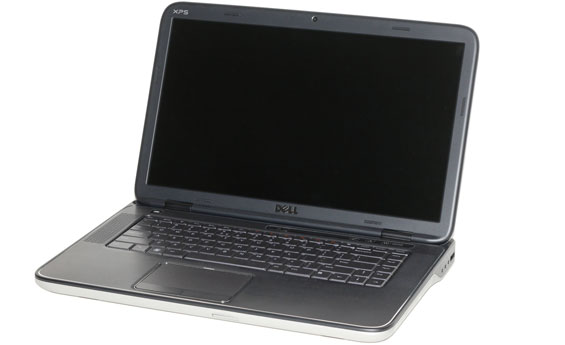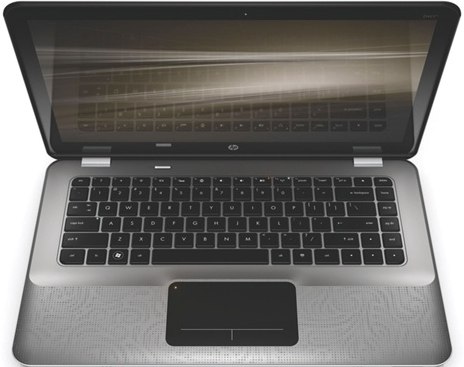Holiday Buyer's Guide: Notebooks
by Dustin Sklavos on November 15, 2010 9:00 PM EST- Posted in
- Laptops
- Guides
- Holiday 2010
Best Mainstream: Dell XPS L501x ($980 with 1080p)
This one should really come as no surprise: it seems like Jarred fell in love with the L501x the moment he laid eyes on it. While some commenters found Dell's styling on their reinvigorated XPS line less than appealing, it must be said: the L501x has a great personality.

Our review unit brought the usual Core i5 along with some new hotness in the form of Nvidia's GeForce GT 420M graphics. While the GeForce GT 430 may not be a very exciting desktop part, it seems to shine a lot brighter in a mobile form factor, as the 420M brings 96 of Nvidia's shader processors to bear and is able to produce gaming performance that can finally catch up with ATI's Mobility Radeon HD 4650/5650 and even scrape or beat the GeForce GT 335M. That kind of advance was a long time coming.
But wait, there's more! The L501x offers an incredibly tantalizing upgrade at a reasonable price: a WLED backlit 1080p screen that ranks among the best we've ever seen. At a time when we'd gotten frankly depressed by the idea of having to test yet another dismal TN panel, the L501x's upgraded screen blew away our testing by producing a staggering 692:1 contrast ratio and 98.3% of the AdobeRGB color gamut, well above the usual 45%-60% we're used to seeing. Oh, and did we mention the speakers are among the best we've heard on a notebook?
Those looking for a well-rounded [Ed: pun intended?] laptop are going to have a hard time doing any better than the Dell XPS L501x, and we gave it our Gold Editors' Choice award.
Mainstream Runner Up: HP Envy 14
You know, it's frustrating because we'd really like to be able to lay hands on the mythical HP Envy 14 that regularly gets recommended in our comments and deliver the final word, and that's part of the reason it hangs out in runner up territory.

HP's Envy 14 brings a Mobility Radeon HD 5650 to the party along with the usual Core 2010 series of processors, and it does this in a unique 14.5" chassis. The performance and high quality design have become the stuff of myth around here, and we'd likely be crucified not to bring up the HP Envy 14, so here we offer it as a potentially worthy alternative to the L501x. We're still waiting on our review unit (we expect it to be personally delivered by Godot), but our comment boards light up each review with glowing endorsements of the Envy 14. It looks great on paper, great in pictures, and everyone loves it, and that's enough for us to tentatively recommend the Envy 14.
Mainstream Alternatives
This one is a bit more difficult, as you need to define the target audience and decide on what classifies as "mainstream". For us, mainstream means that a laptop can do everything reasonably well, even if it doesn't excel in any one area. The XPS L501x works great for music, movies, and even moderate gaming, and the same goes for the Envy 14. If you're looking for something similar but you're willing to give up build quality and features, there are other options of course.
Acer/Gateway are the quintessential budget laptops everyone sees at Wal-Mart, Best Buy, CostCo, etc., and while they may not win any beauty pageants they certainly are affordable! Toshiba also has some viable notebooks in the realm. For those who want it all, the minimum you can spend while still covering your bases is around $750. That will get you a reasonable CPU and dedicated GPU, with switchable graphics giving you better battery life when you don't need the GPU. The Acer 5742G-7200 gives you i5-460M with GT 420M and Optimus, or the Toshiba A665D-S6059 gives you Phenom P920 and HD 5650 with a backlit keyboard; for pure performance, the Acer 5742G definitely has the edge, particularly when you consider the 450MHz clock on the Toshiba's GPU and the fact that even an i3-330M CPU manages to beat the P920 in nearly every benchmark.
If you're willing to sacrifice battery life and give up switchable graphics, a few other alternatives show up. Acer's Aspire 5551G starting at $630 can certainly play games with its dual-core P520 CPU (2.3GHz) and HD 5650 graphics, but again you have to live with the keyboard and overall aesthetic. Toshiba's L655-S5111 gives you a faster Intel i3-370M CPU with the same HD 5650 GPU for $70 more. If you don't mind last-gen DX10 graphics, the Gateway ID49C (i3-370M and GT330M) and ASUS N82Jv (i5-450M and GT335M) also include Optimus and reasonable prices. None of the alternatives really manage to knock it out of the park, with various compromises in each case, but they can all handle just about any task you might want to throw their way.










50 Comments
View All Comments
Cuhulainn - Monday, November 15, 2010 - link
Though I agree with your subject, I'd disagree with the rest. If what you say were true, you'd see high quality LCD options on every laptop, and no glossy plastic enclosures. Manufacturers will continue to make what they believe meets the needs of the market, regardless of what review sites say. Sure, they have some influence, but it's not as though their hands are tied because of these review sites.I like to have the option, especially with Optimus and the like negating power concerns. If volume and weight are concerns, there are still plenty of options without discrete GPUs.
Relax.
beginner99 - Tuesday, November 16, 2010 - link
this.And most casual gamers play on console anyway and not pc.
I would easly pic a i3 IGP + mate 16:10 screen over a discrete one with useless a glossy 16:9 screen.
But for that you need to pay the 500$ "business fee", meaning less power for a 150% price tag.
BrooksT - Monday, November 15, 2010 - link
Could you guys *be* less professional?How about "if you're willing to pay a premium for design and build quality, and accept somewhat lower performance", etc.
Calling it an "Apple tax" is as silly as talking about the "Intel tax" if you opt for a super-premium CPU. Governments impose taxes; companies offer competing value propositions.
And then you get the whole implication that you don't get anything for a tax, which takes us into the political realm.
Please, guys, grow up a bit and take Anandtech in the direction of actual journalism. It's a premium, a tradeoff, a sign of different priorities, a trap for the unwary even, but it is most certainly not a "tax" by any remotely sane definition of the word.
max347 - Tuesday, November 16, 2010 - link
This comment is ridiculous.Obviously someone is getting too old for technology. "actual journalism" is found in newspapers....which my 50 year old dad doesn't even read anymore.
"Apple tax" is a common, well-known piece of jargon. Perfectly acceptable considering the audience and medium.
If you want PC language with oldtyme verbiage and stiffly written articles, read a newspaper. I think the way these articles are presented is just fine.
Aslo though, you could start up your own tech review site, and see how that turns out. I am betting if you take the "actual journalism" route you outline, you will have every stickler and wise guy tearing apart every little mistake in an article. Presented the way they are here, readers can more comfortably approach the writers, and have more of a discussion-style look at the product in question. This is why companies send them things to review- they get feedback. With a stringent fact-article approach, I don't think you would see this level of interaction.
JonBird - Tuesday, November 16, 2010 - link
I totally agree. It was an uncharacteristically low brow comment from a site that I think of as being in the top tier of tech journalism. Aanand must not have edited this article because he would never discredit his site by using this type of non-descriptive fanboy meme.JarredWalton - Tuesday, November 16, 2010 - link
I'll just say this: I specifically asked Anand to look over the MacBook page and make any comments/edits he saw necessary. What you didn't offend him, and he uses a MacBook Pro 15 all the time. Even he will admit that you pay a significant price premium for what amounts to build quality and aesthetics, and that is the "Apple tax" so often referred to. It's such a well-known term that you can even Google definitions, and get stuff like this:http://www.pcmag.com/encyclopedia_term/0,2542,t=Ap...
Osamede - Tuesday, November 16, 2010 - link
Whatever you want to cal it - "Apple tax" is really a polite way of putting it. If someone wanted to be more provocative they could even call it an "Apple cult fee". And Even the marketing term for this: "brand premium" is itself a euphemism for commanding a price over and beyond the intrinsic value of the product when separated from the brand loyalty.A good example of this is the new Macbook Air products. Basically you have in the 11" version what is little more than an Acer 1810 encased in a shiny aluminum package with a few ounces shaven off and the price doubled. The main real value in there is the better screen and that alone cannont explain Apple's blatant price gouging on 2-3 year old CULV products.
So I would say, let them call it what they will. Apple is definitely charging more than what the products are intrinsically worth.
Spazweasel - Tuesday, November 16, 2010 - link
"Intrinsic worth" is subjective.If you add up the cost of components, you don't get to call that "intrinsic worth", because assembly isn't free. Neither is design and engineering. Many people assign no value to this, and that's just plain wrong. Apple spends more on engineering and design than most other companies, and you pay your share of it. Apple's not the "R&D and manufacturing welfare company", nor is Dell or HP or Lenovo or Asus or any other laptop maker.
You also get OS/X with your MacBook, and that's not free either (and please, no BS about "it's FreeBSD/Mach", that's a tiny part of the operating system as a whole). If you choose to throw away the OS and run something else on it, fine, but you're going to pay your amortized part of OS/X's development anyway.
Look, if you don't value where the "extra" money is going, fine, DON'T BUY IT. You're saying "if I, and only I, don't value it, it has no value to anyone and should therefore be free".
Dustin Sklavos - Tuesday, November 16, 2010 - link
Respectfully, Apple's reported profit margins border on the offensive.You would LIKE to justify the increased cost based on all the things you listed, but judging by Apple's current liquidity I'm gonna go ahead and say these things have already been paid for. The rest is just gouging the consumer.
misaki - Monday, November 15, 2010 - link
I believe you guys have the model number wrong for the 2nd asus netbook, 1015pn-mu17 doesn't exist. Your link goes to 1015ped-mu17 which has the n455.1015pem is the n550 counterpart with integrated intel gpu that has 2 versions. MU17 is cheaper by leaving out bluetooth 3.0 and has a smaller battery than PU17.
(I happened to be looking at netbooks recently)